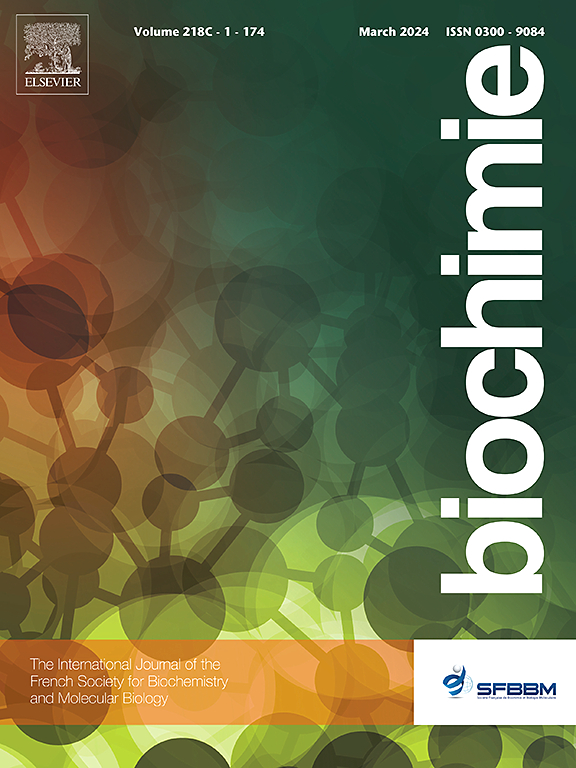大肠杆菌的α溶血素诱导血小板出现类似坏死的促凝血状态。
IF 3.3
3区 生物学
Q2 BIOCHEMISTRY & MOLECULAR BIOLOGY
引用次数: 0
摘要
尿路致病性大肠杆菌(UPEC)是败血症的主要病因,它利用多种毒力因子逃避宿主的免疫反应。值得注意的是,UPEC 产生的α-溶血素(HlyA)与菌血症相关的败血症症状有关,与血小板减少症相关,而血小板减少症是器官功能障碍的关键指标,也是患者预后较差的预测因子。这项研究细致地探讨了亚解质浓度的 HlyA 对血小板的影响。研究结果表明,HlyA 会引发细胞内钙的增加,激活钙蛋白酶并使磷脂酰丝氨酸暴露于细胞表面,流式细胞仪实验也验证了这一点。电子显微镜显示,经 HlyA 处理的血小板呈独特的气球状,表明其处于促凝状态。毒素会诱导细胞外促凝囊泡的释放以及α颗粒和致密颗粒的分泌。总之,研究结果表明 HlyA 会诱导血小板出现类似坏死的促凝状态。亚溶解浓度的 HlyA 对红细胞和血小板的影响可能会对毛细血管微循环产生潜在影响。以 HlyA 为靶点是一种可行的治疗策略,可减轻 UPEC 感染的不良影响,尤其是在这些感染流行的南美国家,这突出了其作为潜在治疗靶点的重要性。本文章由计算机程序翻译,如有差异,请以英文原文为准。
Alpha hemolysin of Escherichia coli induces a necrotic-like procoagulant state in platelets
Uropathogenic strains of E. coli (UPEC) is a leading cause of sepsis, deploying multiple virulence factors to evade host immune responses. Notably, alpha-hemolysin (HlyA) produced by UPEC is implicated in septic symptoms associated with bacteremia, correlating with thrombocytopenia, a critical indicator of organ dysfunction and a predictor of poorer patient prognosis.
This study meticulously explores the impact of sublytic concentrations of HlyA on platelets. Findings reveal that HlyA triggers an increase in intracellular calcium, activating calpain and exposing phosphatidylserine to the cell surface, as validated by flow cytometric experiments. Electron microscopy reveals a distinctive balloon-like shape in HlyA-treated platelets, indicative of a procoagulant state. The toxin induces the release of procoagulant extracellular vesicles and the secretion of alpha and dense granules. Overall, the results point to HlyA inducing a necrotic-like procoagulant state in platelets.
The effects of sublytic concentrations of HlyA on both erythrocytes and platelets could have a potential impact on capillary microcirculation. Targeting HlyA emerges as a viable therapeutic strategy to mitigate the adverse effects of UPEC infections, especially in South American countries where these infections are endemic, underscoring its significance as a potential therapeutic target.
求助全文
通过发布文献求助,成功后即可免费获取论文全文。
去求助
来源期刊

Biochimie
生物-生化与分子生物学
CiteScore
7.20
自引率
2.60%
发文量
219
审稿时长
40 days
期刊介绍:
Biochimie publishes original research articles, short communications, review articles, graphical reviews, mini-reviews, and hypotheses in the broad areas of biology, including biochemistry, enzymology, molecular and cell biology, metabolic regulation, genetics, immunology, microbiology, structural biology, genomics, proteomics, and molecular mechanisms of disease. Biochimie publishes exclusively in English.
Articles are subject to peer review, and must satisfy the requirements of originality, high scientific integrity and general interest to a broad range of readers. Submissions that are judged to be of sound scientific and technical quality but do not fully satisfy the requirements for publication in Biochimie may benefit from a transfer service to a more suitable journal within the same subject area.
 求助内容:
求助内容: 应助结果提醒方式:
应助结果提醒方式:


